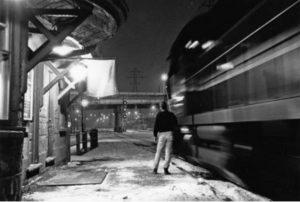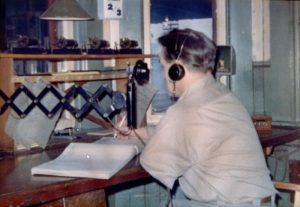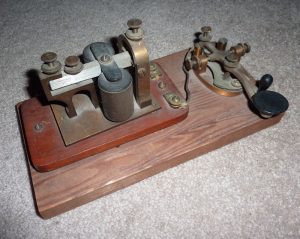On the Line: John Mellow
Communication is key for railway workers. Many trains move along the tracks at all times of the day and night. Workers need to know where trains are and where they are heading. John Mellow started working for the Canadian Pacific Railway in 1963 as a spare telegrapher. As John describes:
Often working alone at stations, operators were heavily relied-upon in the performance of their duties. As they copied and delivered train orders, and then communicated these movements to all concerned both in the dispatching offices and to other stations along the line, the operator was just one cog in the wheel designed to assist in smooth operations of the railway.
– John Mellow, OS Don: Recollections of a CPR Telegrapher and Train-Order Operator (2021), page 61

John Mellow stands on the Don Station platform holding a train order hoop on a wintery night, 1960s.
Train orders first had to get to the train crews. To do this, they used an order hoop, a wooden stick that is curved at the end. The operator stuck the train orders to the hoop and raised it to arm’s length as the train approached. Engineers passing by could reach their arms out of the locomotive window to catch the hoop. Once they removed the orders, the engineer dropped the hoops by the side of the tracks. Sometimes, unpopular operators had to walk far to retrieve their hoops. For telegraph operators like John, it was messy and dangerous work. They had to get very close to moving trains to allow crewmen to catch the hoops. In the time of steam locomotives, they could get dirty from the engine.
When John started working with the railways, he had to complete a Morse code test. He was required to send and receive Morse code at a rate of 15 words per minute. Soon, it became like a second language to him.
[B]efore telephones became more widely used, the adept ability of telegraphers to copy train orders while deciphering Morse code on the telegraph sounder was an art few are able to appreciate in today’s modern world. These skills were taken very seriously, for a mistake left undetected could spell disaster to personnel and property.
– John Mellow, OS Don: Recollections of a CPR Telegrapher and Train-Order Operator (2021), page 61

Train order Operator Clarence Schoester making an entry in the train register book at the desk in Don Station, early 1960s.
Although railway dispatching by telephone first took place in 1909, it faced resistance from workers who felt the telegraph provided similar service with more reliability. Nevertheless, the telegraph could not match the telephone for efficiency – telegrams had to be decoded and returned for confirmation. Nowadays, satellite communication is replacing telephones in a push for even greater efficiency.


